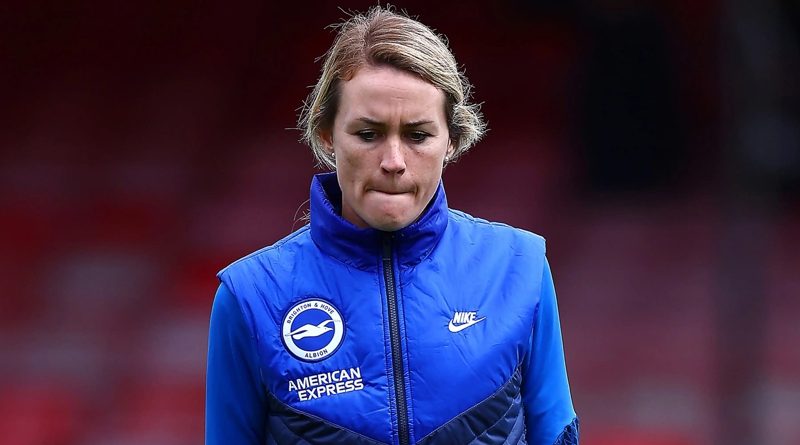The numbers which caused Brighton Women to sack Mel Phillips
On a quiet January transfer window deadline day, the one major surprise for the Albion – and probably across English football as a whole – was the sudden departure of Mel Phillips as head coach of Brighton Women.
This was a change nobody was expecting, least of all Phillips. She had taken the pre-match press conference for the visit to Manchester United at 2.30pm and was then sacked at 6.45pm.
At first viewing, the decision appears to be the complete opposite of Tony Bloom’s meticulously planned stability which has seen the men’s team go from strength to strength, bar the single managerial misstep made with Sami Hyypia.
Phillips had recently expressed a positive view of performances and highlighted the improvements being made, which were in evidence even after the recent 3-0 defeat to Chelsea.
“I’m incredibly proud of the group,” Phillips said. “I think that we’re getting closer and closer in every performance.”
“We had an incredibly disciplined first half and negated a lot of opportunities for them on goal. I don’t think anyone would be deflated after tonight.”
“It’s always an opportunity for us to grow and we know the areas we want to pick up points, we’ll be disappointed we didn’t pick up a point from this game but we’re getting closer. There’s a lot of opportunities left and we need to focus on the big picture vision.”
The Albion seemingly did not agree with Phillips’ big picture vision. In contrast, the prevailing view of pundits and fans initially was to side with Phillips.
There was a mixture of surprise and disappointment, summed up by one Brighton Women fan responding to a WAB post with: “If she’s been sacked, I’m going to seriously consider whether to renew my season ticket. Mel was starting to make a real difference with this team.”
On the surface, there seemed little sense behind the decision. Whilst the Albion would be disappointed to sit 10th in the WSL, the Seagulls were just one win off seventh.
Good progress had been made in both cup competitions under Phillips, reaching the quarter final of the League Cup and the fifth round of the FA Cup.
The timing of the sacking looked equally odd, coming just days after the transfer window closed with Brighton having won three matches out of four since the winter break.
Two potential banana skin ties were navigated away from home against lower league opponents Luton Town (6-0) and Charlton Athletic (2-1) in FA Cup and League Cup respectively.
The 3-0 defeat to Chelsea was not entirely unexpected with the Blues one of the finest teams in Europe. A dramatic 3-2 win over Bristol City showed the fight the squad had playing under Phillips.
There is equally no suggestion that the personable Phillips had any of the issues that led to the sudden departure of her predecessor Jens Scheuer.
After the former Bayern Munich manager was sacked last season, the Daily Telegraph reported: “Several staff and players were unhappy about the way Scheuer had been allegedly speaking to colleagues in meetings, on the training ground and the dressing room, and his dealing with players and other club employees.”
Why did Brighton sack Mel Phillips?
In short, there seemed no obvious reason to relieve Phillips of her duties. Brighton technical director David Weir was left to explain the decision.
“This is not a decision which has been taken lightly, but we feel it is vital for the progress we want to see in the WSL,” said Weir.
“We have invested heavily in the women’s squad and infrastructure going into this season, and results and performances have not been at the level we had expected, given that investment.”
On the men’s side, seasoned Albion observers know that Bloom knows best and he rarely gets decisions like this wrong.
Much that Brighton do is underpinned by data and analytics, including managerial decisions. Graham Potter survived long spells of poor results, in part because the data said he would come good eventually.
Analytics helped lead the Albion to the door of Roberto De Zerbi, a head coach otherwise pretty much unheard of in England before his appointment as Potter’s successor.
It is when you look at the numbers behind Brighton Women’s season so far that sadly, one has to conclude the decision to sack Phillips begins to make sense.
Investment
As Weir said when explaining why Phillips had been sacked, the Albion had invested heavily in their playing squad during the summer transfer window.
11 new players arrived and as was written on WAB at the start of the campaign, the target was clearly progression towards Bloom’s started aim of becoming a top four WSL side.
Did Brighton Women progress or regress under Phillips?
Those questioning the decision to sack Phillips would justifiably state that it takes time for a new team to gel and the gap to the top four is considerable.
Equally, they could point to the very impressive results against the two Manchester clubs in November which showed that gap was beginning to close.
Brighton held Manchester United to a 2-2 draw at home before a brilliant 1-0 win away against Manchester City.
The recent win over Bristol City meanwhile left the Albion six points clear of the one relegation place and looking relatively safe.
Results suggested Brighton had progressed – albeit slowly. They moved from 11th to 10th, taking 11 points from their first 12 matches having acquired 16 across the entire 22-game season in 2022-23.
Albion Women under Phillips were improving results-wise faster than the men did under Potter. So why wasn’t Phillips afforded the same time and patience by Bloom as Potter received?
Brighton Women and xG
Bloom famously built his company Starlizard on the back of applying data analytics to find the edge in sports betting markets.
One key early driver was the realisation that expected goals is a better predictor of future performances than actual results.
As Nate Silver – a talented poker player like Bloom – said, “It’s the numbers, stupid!” And the numbers did not look good for Phillips.
Potter was the King of xG at Brighton and that metric helped keep him in a job. During those long winless spells, xG said the team were performing well and that this in time would naturally need to an upturn in results.
That was exactly happened in Potter’s last 10 months at Brighton. An upturn good enough in fact to land him the Chelsea job and help Bloom pocket £21 million in the process.
Brighton Women in contrast have an xG which makes them statistically the worst team in the WSL – even worse than bottom club Bristol City – and by some distance.
Of their three WSL victories, the Albion lost all but one on xG. Brighton 3-2 Bristol City returned an xG score of 0.6/1.3. Manchester City 0-1 Brighton was 1.0/2.8 on xG. And Everton 1-2 Brighton finished 1.5/1.6.
Transfer xG into expected points, and the nine from those three wins becomes a solitary one from a draw at Everton.
Viewing football through such a cold, analytical approach is not what fans are conditioned to do with the emotional investment we attach to our clubs. Results instead are far more important.
But do you even need xG or expected points to conclude the win at Manchester City was a smash-and-grab and Bristol City were the better side at the Broadfield Stadium?
Six points in those two games were largely down to exceptional individual performances from goalkeeper Sophie Baggaley and forward Elisabeth Terland.
Being outplayed by a Robins outfit bottom of the table with far less investment in playing facilities and staff may well have been the final nail in Phillips’ coffin.
The sad reality was that whilst Brighton had doubled their points-per-game this season, they are almost twice as bad they were in 2022-23 according to xG.
Just like how a positive xG gave Bloom faith Potter would come good, a negative xG suggested that Brighton were heading for trouble under Phillips as their luck would eventually run out.
Different metrics for different teams
The sharpest analysis surrounding Brighton sacking Phillips came from United manager Marc Skinner, speaking before his side welcomed the managerless Seagulls to Leigh Sports Village.
“I was shocked. But what I would say is that there are many metrics that an ownership group will look at and I think they are different for each team,” said Skinner.
“What I would say is that I think it depends on each individual model and I think the coaches know that when they go into it. If you stray against it, you will know exactly where you’re at”.
Phillips strayed against arguably the most important metric of all at Brighton – expected goals – and has paid the price.
The Brighton DNA
Of course ,there are other factors at play. Albion academy coach Mikey Harris has been placed in interim charge and his first duty was to repeat Phillips’ last and speak in a Manchester United press conference.
Harris’ most telling contribution was to unwittingly confirm what was the second nail in Phillips’ coffin – the clash between how the Seagulls played under her and the Brighton DNA.
When asked by Brian Owen of The Argus about his footballing philosophy, Harris said: “It would just align to the football clubs really. We want to dominate the ball, we want to have more of the ball than the opposition, we want to play exciting football.”
Despite all the success Chris Hughton brought to Brighton, he was not immune from the requirement that Albion managers have to play in a certain way. That evolution has continued from Hughton to Potter to De Zerbi.
Phillips’ style was always closer to Hughton than Potter or De Zerbi. She opted for an ultra-defensive approach against the WSL Big Four, whilst Brighton overall have the worst possession percentages numbers of any team bar Bristol City.
That possession percentage is down on last season, suggesting Phillips was taking Albion Women in the opposite direction to where the club would want them to be going.
Another key aspect of the Brighton DNA is giving young players opportunities. Whilst a summer recruitment drive focussing on experienced players was always likely to raise the average age of the starting XI, it has jumped from 25.8 last season to 27.3 this time around.
The club might also point to attendances as a reason for sacking Phillips. The average WSL attendance has risen by 55 percent, whereas for the Albion it has stayed broadly the same from 3,427 in 2022-23 to 3,571 in 2023-24.
How much that is down to Phillips’ style of play and how much it is because of home games being played in Crawley is a matter for debate.
Less contentious is that the numbers and analytics show Phillips’ Brighton side were at odds with the way the club wants to be run across the board.
Whilst the initial shock and surprise at her sacking was justified, in truth it was always a question of when Phillips would leave the club rather than if.
Peter Finn




